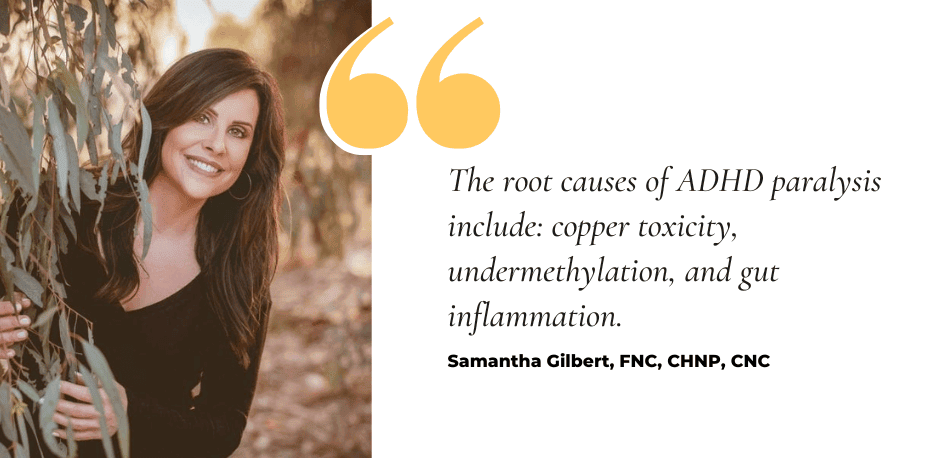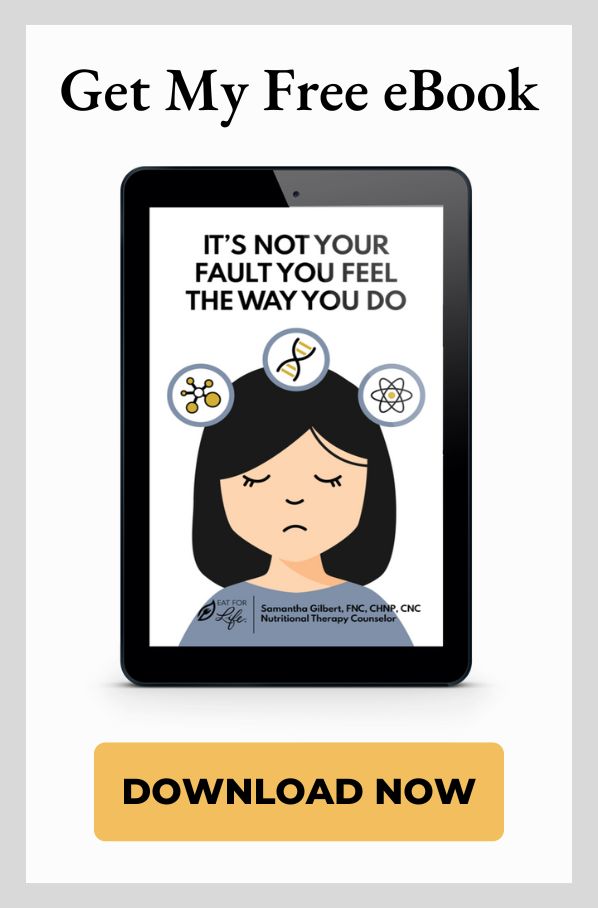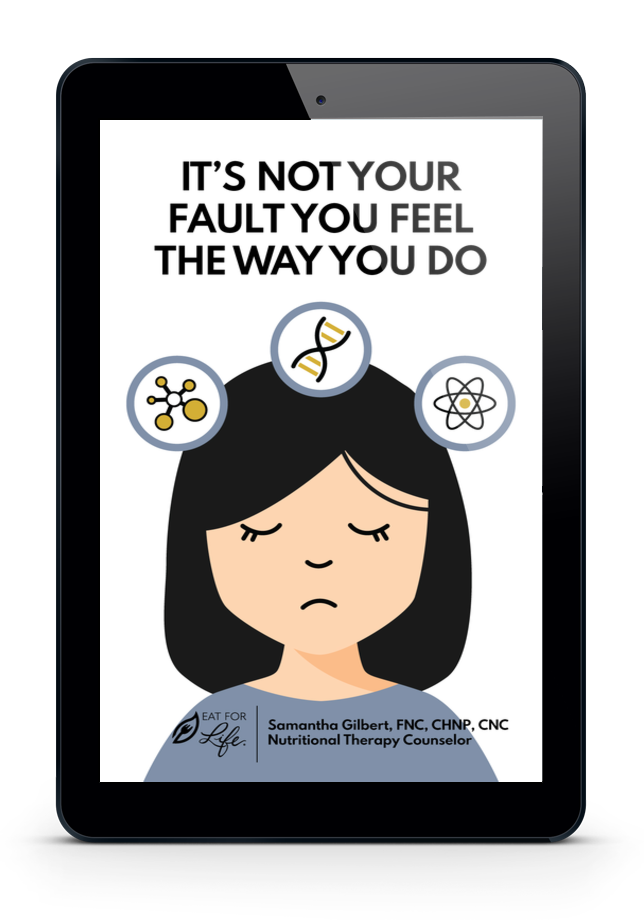ADHD paralysis is a phenomenon where individuals with ADHD find it hard to start or complete tasks. ADHD paralysis, or executive dysfunction, can manifest as procrastination, indecision, and inaction. It’s not about laziness or lack of willpower. It’s a neurobiological issue but if we go even deeper, we see that biochemical imbalances and infection are the root causes, which I’ll be going over in this episode.
I believe sharing is caring, so I have a favor to ask. If my show is helpful to you, please share this podcast and consider leaving a review in Apple Podcasts. It is through sharing that we create community, eliminate guilt and shame, and bring about healing. Thank you in advance for taking three minutes out of your day to support my show so others can find me.
In this episode, I discuss:
- ADHD paralysis, also known as executive dysfunction, is a neurobiological issue where individuals with ADHD struggle to start or complete tasks due to procrastination, indecision, and inaction.
- Common strategies to manage ADHD paralysis include breaking tasks into smaller steps, using timers, and establishing routines, though these do not address underlying biochemical imbalances and are only effective for some individuals.
- Rising ADHD diagnoses, particularly during the pandemic, highlight an expanding public health concern, with socioeconomic factors influencing diagnosis rates and severity.
- ADHD is often associated with other conditions like OCD, anxiety, and learning disabilities, and it may be influenced by inherited genetic and environmental factors.
- The three biochemical subtypes linked to ADHD paralysis are copper toxicity, undermethylation, and gut inflammation, each requiring specific nutrient therapy and dietary adjustments to manage symptoms effectively.
Listen to the podcast here:
Links:
- ADHD Prevalence Among U.S. Children and Adolescents in 2022
- Facts About ADHD Throughout the Years
- The Gut-Brain Connection
- How to Overcome Anxiety Through Nutrition—A Primer on Improving Mental Health
Individuals with ADHD often struggle with planning, prioritizing, and executing tasks. The more daunting or tedious the task, the harder it is to start or complete it. There are lots of strategies online about how to cope with ADHD paralysis such as:
- Breaking down large intimidating tasks into smaller, manageable tasks.
- Set a timer for a specific period of time to work on a task. When the timer goes off, take a short break.
- Implementing routines that provide structure and make tasks more predictable.
There’s no question these strategies can help some individuals, but they won’t affect the underlying biochemical imbalances that cause ADHD paralysis. Before I discuss the underlying causes of ADHD, and because I work with many families and children, I’d like to share some stats with you.
Rising ADHD Diagnoses: Understanding Trends and Public Health Concerns
Since the first national survey asking parents about ADHD in 1997, there has been an upward trend in parent-reported ADHD diagnoses across different surveys and age ranges. It is unclear whether this increase reflects a change in the number of children with ADHD or in the number of diagnoses. However, the most recent estimates are consistent with previous ones.
A new study confirms what I’ve been saying for years: diagnoses of attention-deficit/hyperactivity disorder (ADHD) are becoming an “expanding public health concern.”
Approximately 1 in 9 U.S. children, about 7 million, were diagnosed with ADHD in 2022, according to the study published in May. This marked about 1 million more children diagnosed compared to 2016, indicating a significant increase in the diagnosis rate among U.S. children.
The Impact of Increased Awareness and Pandemic Stress
The study’s authors suggested that the rise in diagnoses might be due to increased public awareness and a greater tendency to seek care for the disorder, or it could be related to changes in children’s development during the COVID-19 pandemic.
“Pandemic-associated family stressors such as illness and death in the family and community, changes in parental work and child schooling, decreased social interactions and increased fear and uncertainty are factors that can increase symptoms of inattention, impulsivity, and hyperactivity.”
Without question, the pandemic had a devastating impact on our nation’s children. However, even without the lockdowns, the increased rates of ADHD would still be the same.
The study also highlighted that historically, boys have been diagnosed with ADHD at much higher rates than girls. However, an analysis of prescription medication claims from 2016 to 2021 revealed an increase in the number of girls and teens aged 10 to 19 receiving medications.
ADHD and Socioeconomic Factors: How Income Levels Affect Diagnosis Rates
The researchers also observed variations in clinical characteristics. Children from lower-income households or those on public health insurance were more likely to have a higher number of diagnoses and more severe cases of ADHD. And of course we know why this is the case: children from lower income households often do not have access to quality food because their parents cannot afford to feed them a nutrient-dense diet or provide them with needed nutrient supplementation.
ADHD Treatment Statistics: Medication and Behavioral Therapy Trends
Per the CDC, “Estimates for receiving any ADHD treatment among children with current ADHD vary from 58% to 92% across states. ADHD treatments include medications account for 38% to 81%, and behavioral therapy varying from 39% to 62%.”
While it’s true we live in a time where technology and screen time has literally changed how our brains process information, this doesn’t account for the staggering rise in attention deficit disorders and their resulting challenges such as ADHD paralysis.
Why is ADHD on the Rise?
Like autism, ADHD is part of a cluster of symptoms that includes OCD, oppositional defiant disorder (ODD), anger and rage, depression, anxiety, extreme temper tantrums and mood swings, sleeping difficulties, problems with digestion, and learning disabilities such as dyslexia, to name a few.
And it’s not just limited to one family member. If you take a step back and look closely, you’ll often notice other family members share these cluster symptoms. This is because ADHD is often an inherited condition, something called transgenerational epigenetic inheritance.
Epigenetics is the science of how your genes perform over your lifetime and whether those changes can be passed down to future generations and is influenced by environmental factors that impact your ability to think, focus, and concentrate effectively.
Environmental factors include things like the 4×4 burger, animal style fries, and Neapolitan shake you had at In & Out for lunch. It’s not simply about the genes and not simply about the environment. Both are factors that contribute to biochemical imbalances in the brain, which in turn can affect you and your child’s functional capacity.
So instead of putting your child on medications, I encourage you to think about your child’s diet and how nutrient deficiencies and overloads impact brain function and development.
What is the Root Cause of ADHD?
The 3 biochemical subtypes associated with ADHD paralysis include:
- Copper Toxicity or Overload
- Undermethylation
- Gut Inflammation
ADHD and Copper Toxicity
First up is copper, an essential mineral that’s necessary for various physiological processes in the human body. While you need copper, too much can cause a lot of inflammation. One of the most common sets of symptoms associated with copper toxicity involve neurological problems that significantly impact the brain and nervous system. This is because copper lowers dopamine (a neurotransmitter that controls the brain’s pleasure and reward centers) and increases norepinephrine (another neurotransmitter that also functions as a stress hormone) in the brain.
When you have too much copper you get short-circuiting of brain processes, which can result in inattention and hyperactive behaviors. In my clinic, I run lab tests for a variety of additional elements that affect hyperactivity, focus, attention, and anxiety. For example, individuals that are low in zinc have a really hard time regulating GABA, a calming neurotransmitter that is present in the brain. So a proper copper/zinc balance contributes to alleviating symptoms of ADHD paralysis. Also known as metal dysmetabolism, the body stores excess copper and needs targeted nutrient supplementation to keep the copper/zinc ratio at an optimal level.
ADHD and Undermethylation
The second of the three biochemical subtypes is undermethylation. Methylation is the body’s ability to turn enzymes, hormones, neurotransmitters, and other chemicals on or off using methyl groups. Methyl groups (Me) consist of one carbon atom bonded with three hydrogen atoms. These groups can significantly alter your perceptions and behavior and can even influence your future job prospects.
People with few methyl groups, known as undermethylators, tend to be perfectionistic, persistent, and high-achieving because they have low levels of serotonin, dopamine, and norepinephrine. Low levels of these neurotransmitters are common in those with ADHD paralysis. Other attributes of undermethylation include headaches, seasonal allergies, addictive tendencies, ritualistic behaviors, and phobias.
Regarding serotonin, the issue specifically relates to low activity at serotonin receptors due to rapid reabsorption after serotonin is released into a brain synapse. It’s not so much a serotonin deficiency, but an inability to keep serotonin in the synapse long enough. Additionally, undermethylated individuals often have high blood levels of histamine, another neurotransmitter.
Undermethylators usually respond well to serotonin-enhancing substances, but increasing serotonin alone doesn’t fix the underlying issue. Nutrient therapy is needed to support the creation of methyl groups and to increase important master antioxidants, such as glutathione and metallothionein.
ADHD and Gut Inflammation
The final biochemical subtype is gut inflammation and it’s an important one because everyone in my practice with ADHD paralysis has some form of gut infection. Keep in mind you don’t have to have problems with your digestion to have a gut infection that can impact your brain. Your gut microbiome is a highly intelligent ecosystem of organisms. Bacteria tend to dominate this ecosystem, but you’ve also got viruses, fungi, and protozoan, among other organisms that exist there. When the bi-directional connection between the brain and the gut (also called the gut-brain axis) is underdeveloped, and/or the ecosystem becomes imbalanced, I often see ADHD paralysis.
An imbalance in the ecosystem is the most common culprit due to poor diet, stress, and nutrient deficiencies that support the gut lining and organ function such as insufficient pancreatic enzymes or bile acids to break down your food. Often this presents itself as very high levels of candida and opportunistic bacteria that can turn pathogenic.
Now candida is interesting because not only is it a mast cell activating yeast, but it’s also an alcohol producer that feeds off sugars and ultra processed foods, which is why I see it so much in children. If your child seems loopy or drunk at times, it’s most likely the candida taking over. If the infection isn’t addressed, they will continue to have myriad symptoms as they get older such as eczema and acne, brain fog, chronic fatigue, high anxiety, joint pain, increased sensitivity or intolerance to certain foods, temper control problems, and anger and rage to name a few.
In adults, candida can be a contributing factor to autoimmune diseases such as rheumatoid arthritis and Hashimoto’s. I’ve talked a lot about the gut brain connection in previous episodes, which are linked above.
As always, thanks for being with me today. My prayer is that this episode has blessed you in some way, and I look forward to being with you next time.
I believe sharing is caring, so I have a favor to ask. If my show is helpful to you, please share this podcast and consider leaving a review in Apple Podcasts. It is through sharing that we create community, eliminate guilt and shame, and bring about healing. Thank you in advance for taking three minutes out of your day to support my show so others can find me.







2 Responses
Hi Sami. I am so confused after listening to podcasts. How do I know if I am an overmethylator by my chemistry. I never had Mthfr but I know I am – – comt..(fast) I had copper zinc blood work and both were normal. I quit all supplements atm except zinc 25mg. And mag . I’m a rectal cancer survivor and don’t want it to come back. I occasionally take niacin.
Hi Dea,
We determine methylation and other biochemical imbalances with labs. If you are interested in working with me, click here for more information.